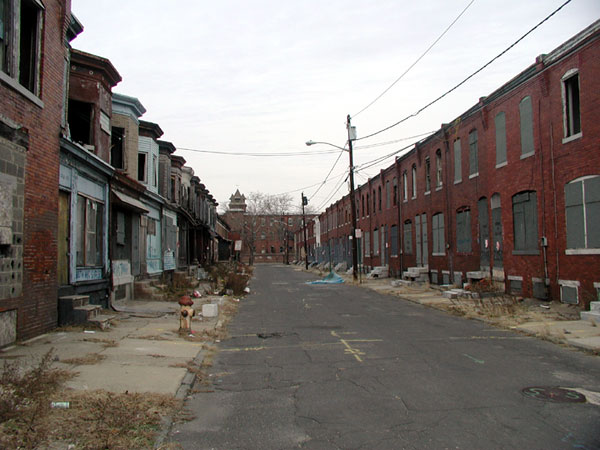The harsh economic climate is changing. The time has come when citizens and companies aren’t the only ones being forced to file for bankruptcy…
Major cities are among the ranks of those in dire straits.
On Wednesday, Pennsylvania's capital city Harrisburg opted for the rarely used Chapter 9 of the U.S. bankruptcy code.
The current struggle is between the state and city of Harrisburg over control of the city, whose population of around 50,000 people had been having difficulties paying for critical services for over the past year. On top of that, the city has incurred as much as $458 million in debt and several lawsuits with creditors.
“The city does not have the ability to pay those money judgments or any significant portion thereof and still provide health and safety services to its citizens and other essential government services,” said Mark Schwartz, an attorney hired by the City Council.
According to Schwartz, bankruptcy gives the city “bargaining power” with its creditors, municipal workers, retirees, and the state.
"Municipal bankruptcies are rare. But if Harrisburg is successful in winning concessions with bondholders, pensioners and other stakeholders, it could lead other financially troubled cities to seek bankruptcy."As of 1937, only 629 municipal bankruptcies under Chapter 9 of the U.S. Bankruptcy Code have been filed. Most recent of these is Orange County, California, which filed for bankruptcy back in 1994, and Vallejo, California, following in 2008.
Is your city or town next to fall onto the sword and file for Chapter 9?
The 7 U.S. Cities on the Verge of Bankruptcy
Washington, D.C.
 | ||||||
| City | Population: | Deficit through 2012: | Budget in Fiscal year 2012: | Annual Budget Shortfall: | Deficit per Capita: | 2011 Unemployment Rate |
| Washington, DC | 599,657 | $322 million | $9.6 billion | 3.4% | $537 | 11.1% |
Still, Gray's plan will leave the Washington Metro Area in the red. He says the budget would inflict some pain: “[It’s] a tough budget, I'm not going to represent it as anything else,” he admits. Yet little more than a week after his budget plan was announced, he was arrested for protesting that Congress (which oversees the DC budget and laws) was taking away autonomy granted to the city for the last several years, meaning it will be banned from spending city money on things such as HIV prevention.
Detroit, Michigan
 | ||||||
| City | Population: | Deficit through 2012: | Budget in Fiscal year 2012: | Annual Budget Shortfall: | Deficit per Capita: | 2011 Unemployment Rate |
| Detroit, Michigan | 713,777 | $155 million | $3.11 billion | 5% | $217 | 12.9% |
Recently cited in a Reuters poll as highest potential candidate for municipal bankruptcy, Detroit mayor Dave Bing has tried to work with the Republican-controlled Michigan Legislature – but has struggled. His budget-balancing proposals include a higher tax on Detroit casinos, pension reforms, the suspension of state drive licenses for three unpaid Detroit parking tickets, and continuing to collect income and utility taxes. With the city’s dropping population comes less money generated from taxes, sinking the Motor City in even deeper debt.
Honolulu, Hawaii
 | |||||||
| City | Population: | Deficit through 2012: | Budget in Fiscal year 2012: | Annual Budget Shortfall: | Deficit per Capita: | 2011 Unemployment Rate | |
| Honolulu, Hawaii | 905,034 | $100 million | $1.93 billion | 5.1% | $110 | 5.2% | |
Honolulu Mayor Peter Carlisle was investigated by the local Honolulu Civil Beat which went on to reveal the Mayor had budgeted more than $43 million to fund 1,095 unfilled jobs for 2012. Carlisle’s first budget plan set out to tackle long-term debt; he said he would raise taxes and fees while asking unionized city workers for 5% pay cuts.
New York City, New York
 | |||||||
| City | Population: | Deficit through 2012: | Budget in Fiscal year 2012: | Annual Budget Shortfall: | Deficit per Capita: | 2011 Unemployment Rate | |
| New York City, NY | 8.1 million | $4.58 billion | $65.7 billion | 7% | $565 | 8.7% | |
Mayor Michael Bloomberg has already begun to address the FY2012 deficit by calling for layoffs in all city agencies, closing 20 fire departments during night hours, and reducing services for seniors, libraries, and cultural centers. Bloomberg dismissed around 6,000 of the city’s 75,000 teachers in June before the state passed its $66 billion budget with note to no more teacher layoffs. The New York City Mayor's office has predicted the city's budget gap could rise to $4.4 billion.
Chicago, Illinois
 | |||||||
| City | Population: | Deficit through 2012: | Budget in Fiscal year 2012: | Annual Budget Shortfall: | Deficit per Capita: | 2011 Unemployment Rate | |
| Chicago, Illinois | 2.7 million | $636 million | $8.2 billion | 7.7% | $2353 | 10.2% | |
Chicago's former mayor Richard Daley destroyed the Windy City’s finances by using up nearly the entire revenue from a long-term lease of the local parking system and airport. The lease was supposed to last until 2018, but only made it to 2010. Chicago hopes to build a city-owned casino to raise revenue. Meanwhile, newly-elected Mayor Rahm Emanuel's first budget proposal was unveiled and focuses on large cuts. His new plan consolidates police and fire headquarters, reduces library hours, and takes out 2,000 vacant jobs – some of them police – out of the budget. Emanuel’s plans include the layoffs of more than 500 people.
Cincinnati, Ohio
 | |||||||
| City | Population: | Deficit through 2012: | Budget in Fiscal year 2012: | Annual Budget Shortfall: | Deficit per Capita: | 2011 Unemployment Rate | |
| Cincinnati, Ohio | 331,285 | $60 million | $1.2 billion | 20% | $181 | 8.7% | |
The City of Cincinnati has been keeping much of its fiscal policies quiet, only briefly announcing budget cuts and layoff plans for the past two years. Many believe the city’s limited announcements are in preparation to file for bankruptcy… Mayor Mark Mallory has been holding off discussion of the proposal set forth that the city will not lay off police officers in 2011 or 2012. Mallory is using his “campaign season” as an excuse to avoid addressing his plan to lay off police officers in the next two years while outsource the force to the neighboring city of Hamilton and dismantling the Office of Environmental Quality.
Camden, New Jersey
 | |||||||
| City | Population: | Deficit through 2012: | Budget in Fiscal year 2012: | Annual Budget Shortfall: | Deficit per Capita: | 2011 Unemployment Rate | |
| Camden, New Jersey | 517,234 | $28 million | $138 million | 20.2% | $54 | 11.1% | |
Newly-elected Mayor of Camden, Dana Redd, came into power and began ruling with a strong fist, but she still has a long way to go to dig the nation's most dangerous city out of deficit… In her 2011 budget proposal, Redd called for departmental budget cuts of 24%, a $4 million reduction in operating costs, a freeze on all non-essential spending, $7.5 million in cost reductions to the Fire Department, and worst of all, a $14 million reduction to the Camden Police Department – which in turn, cut the entire force in half.
Bonus list: Practically every major city in California: San Diego, San Jose, San Francisco, Los Angeles
San Diego
 | |||||||
| City | Population: | Deficit through 2012: | Budget in Fiscal year 2012: | Annual Budget Shortfall: | Deficit per Capita: | 2011 Unemployment Rate | |
| San Diego | 3 million | $56.7 million | $2.8 billion | 2% | $19 | 10.2% | |
Despite cuts within the public and higher education sectors and fire engine cutbacks, San Diego is still in a deep hole. The fire stations had thousands of blackouts as the cuts rotated throughout different stations to save $11.5 million the current fiscal year. Weekly recreation center hours will be reduced to 20 hours, and the equivalent of 77 full-time positions were cut, saving $6.5 million. The city proposed 6% pay cuts for employees and has cut out 120 full-time positions.
San Jose
 | |||||||
| City | Population: | Deficit through 2012: | Budget in Fiscal year 2012: | Annual Budget Shortfall: | Deficit per Capita: | 2011 Unemployment Rate | |
| San Jose | 894,943 | $115 million | $2.5 billion | 4.6% | $128 | 10% | |
San Jose Mayor Chuck Reed said it best, “Whether or not we declare an emergency, we're in an emergency. We just laid off police officers. Last year, we laid off firefighters. We've closed libraries, community centers. We are in an emergency and we need to take action.” Reed also looks to close the deficit by reducing services and controlling the cost of retirement.
San Francisco
 | |||||||
| City | Population: | Deficit through 2012: | Budget in Fiscal year 2012: | Annual Budget Shortfall: | Deficit per Capita: | 2011 Unemployment Rate | |
| San Francisco | 808,976 | $380 million ($480mil for '12-'13, $642mil for '13-'14) | $6.8 billion | 5.5% | $470 | 9.7% | |
Mayor Edwin Lee presented his $6.8 billion budget proposal aiming to close the $380 million shortfall caused by growth in employee benefit costs and loss of revenues from state and federal government. The city will cut San Francisco's deficit by forgoing scheduled pay increases for city employees – saving $20.2 million – and enacted a hiring freeze.
Los Angeles
 | |||||||
| City | Population: | Deficit through 2012: | Budget in Fiscal year 2012: | Annual Budget Shortfall: | Deficit per Capita: | 2011 Unemployment Rate | |
| Los Angeles | 9.8 million | $457 million | $6.9 billion | 6.6% | $46 | 13.3% | |
Mayor Antonio Villaraigosa closed a $336 million shortfall with large cuts to the police and fire departments while also cutting $19 million from Recreation and Parks Department. Also, Los Angeles' homelessness programs reduced funding by 10%, and permanent cuts to city spending have been made while reducing funds for public safety, library operations, and street preservation and maintenance.
*Combining all these four California cities, you get a deficit of $1.01 billion, a budget of $19 billion, and an annual budget shortfall of 5.3%. The unemployment rate of the four cities totals 10.8% or 1.572 million unemployed.
In June, Governor of California Jerry Brown signed the most austere fiscal package in decades. The package contains $15 billion dollars in cuts including:
$5 billion in health and human services
$1.3 billion in higher education
$1 billion in corrections
$350 million in the state's court system
$700 million in state employment compensation and governmental efficiencies
$400 million in California Community Colleges
The budget also has a clause for $2.5 billion in triggered cuts, meaning if anticipated revenue doesn't equate, there will be additional mid-year reductions in public education, public safety, higher education, and health and human services.
If it seems like a handful of California cities are in a financial bind… the entire Golden State is actually teetering on the edge of bankruptcy... as are many other of the major cities in the United States.

沒有留言:
發佈留言